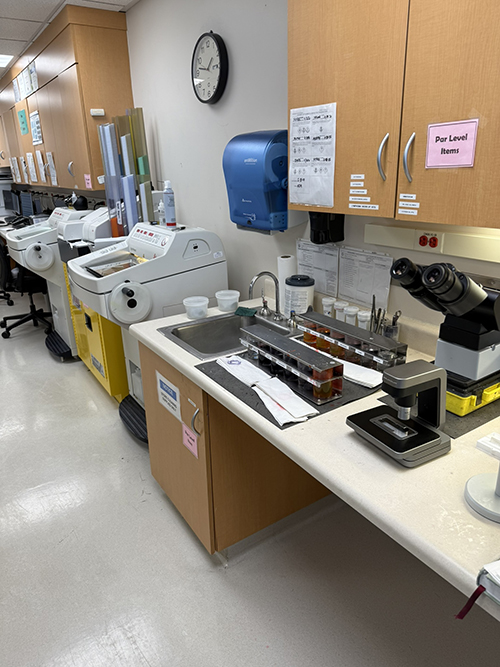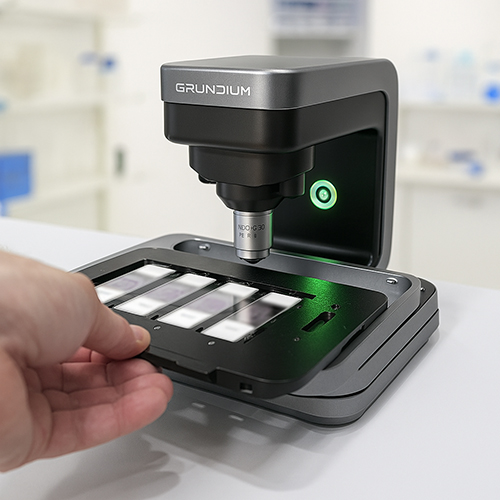Join us for a timely webinar featuring industry experts as they shared how their pathology department is reducing diagnostic risk and accelerating turnaround times through cutting-edge digital pathology tools.
60-Minute Webinar Sponsored By


As cancer incidence continues to rise, the demand for fast, accurate diagnosis is outpacing the availability of pathologists and qualified lab staff. This imbalance is especially critical for complex cases requiring second opinions—where delays can compromise care and outcomes. Traditional consult workflows are often slow, fragmented, and vulnerable to sample loss, creating unnecessary risk for the very patients who need precision and speed the most.
In this webinar, experts shared how their pathology department is leveraging digital pathology tools to transform consult workflows. From telepathology to AI-powered diagnostics, this laboratory is setting a new standard for efficiency, collaboration, and clinical impact.
Join us for "Driving Consult Efficiency: How a Premier Healthcare Organization and its Partners Leverage Integrated Digital Pathology" This webinar, sponsored by Grundium and hosted by Dark Daily, delivered actionable insights into how digital pathology tools can reduce turnaround times and optimize consult workflows.
Key Learning Objectives:
- Identify the challenges presented for pathology consultations and second opinions due to shortages of qualified pathologists and lab staff
- Assess how digital pathology tools address skill and staff shortages
- Predict common IT challenges with implementing new digital pathology tools

Expert Speakers
Anil Parwani, MD
Chair, Department of Pathology and Chief of Laboratory Services Ohio State University Wexner Medical Center Columbus, Ohio
Dr. Anil Parwani is a Professor of Pathology and Biomedical Informatics at The Ohio State University. He serves as the Donald A. Senhauser Chair of the Department of Pathology and the Chief of Pathology Services for the Health System. His research is focused on diagnostic and prognostic markers in bladder, prostate, and renal cell carcinoma. Dr. Parwani has expertise in surgical pathology, and pathology informatics including biobanking, whole slide imaging, digital imaging, telepathology, image analysis, artificial intelligence, and lab automation. Dr Parwani has authored over four hundred peer-reviewed articles in major scientific journals and several books and book chapters. Dr. Parwani is the Editor-in-chief of Diagnostic Pathology and Co-editor of the Journal of Pathology Informatics.
Melinda Schumacher, MD
Pathologist Ohio State University Wooster Community Hospital Wooster, Ohio
Melinda Schumacher, MD is an Associate Professor-Clinical in the Community Pathology Branch. Dr. Schumacher earned her MD in 1982 from Wright State University School of Medicine in Dayton, OH. She began her residency in anatomic and clinical pathology at Kettering Medical Center in Kettering, OH, subsequently completing it at The Ohio State University in 1987. She continued and completed her training at Ohio State with a fellowship in medical microbiology in 1988. Dr. Schumacher is a Community general pathologist with a focus in GI pathology and an interest in dermatopathology. She is a proponent of digital imaging in support of enhanced work flow and turn-around-times, plus ease of consultation with continual learning and enhancement of pathologists’ diagnostic skills.
Scott Hammond
Clinical Research Manager, Comparative Pathology & Digital Imaging Ohio State University Wexner Medical Center
Scott Hammond is Senior Systems Consultant and a key member of the digital pathology program at The OSU Wexner Medical Center & OSUCCC – James. OSU’s nationally recognized division processes over 2,400 slides daily and maintains one of the world’s largest whole-slide image archives—over 4.7 million slides across 500,000 cases. Scott oversees infrastructure including digitization, workflow implementation, consultations, and quality assurance. He supports remote diagnostics, real-time collaboration, teaching, and research, and leads clinical research efforts for FDA platform and device validations. His administrative leadership has been instrumental in OSU’s pioneering use of digital pathology for primary diagnoses since 2018, helping advance fast, accurate, and scalable pathology services.
Hosted By


